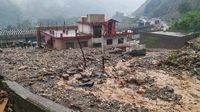At least 51 lives have been lost and several more remain missing after relentless rains unleashed deadly landslides and flooding across eastern Nepal, with the mountainous district of Ilam bearing the brunt of the devastation. The disaster, which struck over the weekend of October 4-5, 2025, has left entire villages in ruins, upended travel across the country, and prompted both a massive domestic rescue effort and offers of international aid.
According to Nepal’s National Disaster Risk Reduction and Management Authority, the death toll climbed steadily as heavy rainfall battered the region from Friday onward. The eastern district of Ilam in Koshi province reported the highest number of fatalities, with at least 37 people killed there alone. In one particularly harrowing incident, six members of the same family were crushed to death when a landslide swept through their home as they slept, Illam’s assistant administrative officer Bholanath Guragai told reporters, as cited by CNN.
Elsewhere, the toll continued to rise. One person died in a neighboring district from a separate landslide, while three people lost their lives after being struck by lightning in another district. In southern Nepal, three more people drowned in flooding. As of Sunday evening, the total number of confirmed deaths reached at least 51, according to figures reported by both CNN and Reuters. Authorities warn that with several people still missing and rescue efforts ongoing, the final tally may yet climb higher.
Rescue operations have been hampered by the very conditions that triggered the disaster. Roads in and out of the hardest-hit villages have been swept away or blocked by mud and debris, making it nearly impossible for ground teams to reach survivors. Persistent rainfall and treacherous terrain have further complicated the situation. “Rainfall was hampering efforts to reach the villages and many roads were swept away or blocked by the landslides,” officials said, as reported by CNN.
Despite these challenges, Nepalese authorities have mounted a determined response. Security forces have been deployed to airlift survivors from isolated communities, including a pregnant woman whose dramatic rescue was highlighted by local media. Helicopters have been used to evacuate those in need of urgent medical care, while ground troops are working tirelessly to move residents to safer areas. The government declared a national holiday through Monday, October 6, to facilitate the emergency response and keep people off dangerous roads.
The timing of the disaster has only compounded its impact. The landslides and flooding struck just as hundreds of thousands of Nepalese were making their way back to Kathmandu after celebrating Dashain, the country’s biggest festival. Thursday, October 2, marked the main day of the two-week-long festival, a period when families traditionally reunite in their home villages. As the holiday wound down, highways were jammed with vehicles and travelers returning to the capital. The sudden closure of major highways—ordered by the government as a precaution and due to physical blockages—left many stranded. According to CNN, by Sunday evening, only one major route into Kathmandu had been partially reopened for traffic.
In the capital itself, some riverside neighborhoods were inundated, but officials reported no major casualties or significant property damage. The government, erring on the side of caution, kept domestic flights grounded throughout Saturday due to poor visibility and hazardous weather conditions. Although flights were permitted to resume on Sunday, night-time movement and air travel remained suspended as of the evening of October 5, reflecting ongoing safety concerns.
Nepal’s meteorological authorities had issued a severe rainfall warning for the eastern and central parts of the country from Saturday through Monday, anticipating the risk of further landslides and flooding. The monsoon season, which typically runs from June to mid-September, had already overstayed its welcome this year. The late-season deluge caught many communities off guard, exacerbating the risk for those living in vulnerable mountain areas.
Tragically, this is not the first time Nepal has faced such devastation. Flooding and landslides during the same period last year claimed 224 lives and left 158 injured, a grim reminder of the country’s chronic vulnerability to climate-driven disasters. The steep, deforested slopes of eastern Nepal are particularly prone to landslides when saturated by rain, and the region’s remote settlements often lack the infrastructure needed for rapid evacuation or relief.
As the scale of the catastrophe became clear, India—the giant neighbor that surrounds landlocked Nepal on three sides—offered its support. Indian Prime Minister Narendra Modi expressed his condolences and solidarity on social platform X, stating, “The loss of lives and damage caused by heavy rains in Nepal are distressing. We stand with the people and Government of Nepal in this difficult time. As a friendly neighbor and first responder, India remains committed to providing any assistance that may be required.” While Nepalese officials had yet to publicly respond to the offer as of Sunday evening, the gesture underscored the close ties and shared vulnerabilities of the two Himalayan nations.
The government’s immediate priority remains search and rescue. With several people still unaccounted for, security forces, emergency workers, and local volunteers continue to comb through debris and mud, hoping to find survivors. The reopening of some transport routes as weather conditions slowly improve has allowed relief teams to reach additional communities, though many areas remain cut off. The authorities have also begun to ease certain travel restrictions, but caution that night-time movement and flights will stay suspended until conditions are deemed safe.
For those who survived, the road to recovery will be long and arduous. Entire villages have been swept away, homes destroyed, and livelihoods lost. The trauma of losing family members and neighbors lingers in the air, even as the immediate threat from the weather begins to recede. The government, aid agencies, and international partners will need to coordinate closely to provide shelter, food, and medical care for those displaced by the disaster.
As Nepal counts its losses and begins the slow process of rebuilding, the events of October 2025 serve as a stark reminder of the country’s exposure to natural hazards—and the urgent need for improved disaster preparedness. With climate change expected to bring more erratic weather patterns and intense rainfall to the region, the challenge of protecting Nepal’s most vulnerable communities is only growing more daunting.
Even as the rains subside and rescue helicopters continue their sorties, the people of Ilam and surrounding districts are left to pick up the pieces, their resilience tested once again by forces beyond their control.




